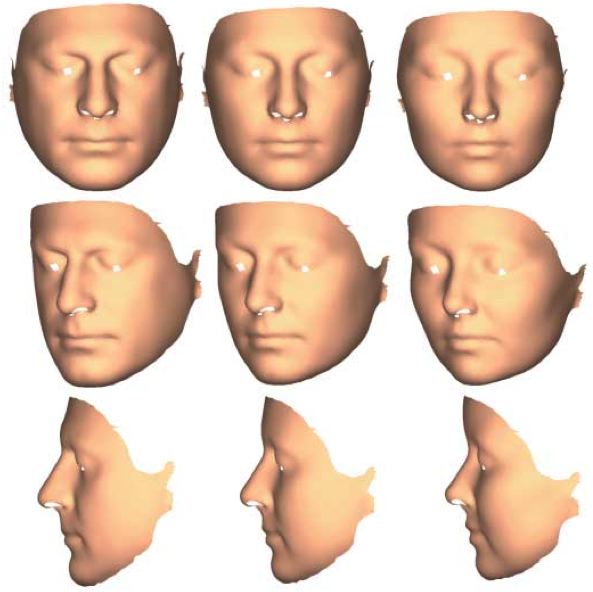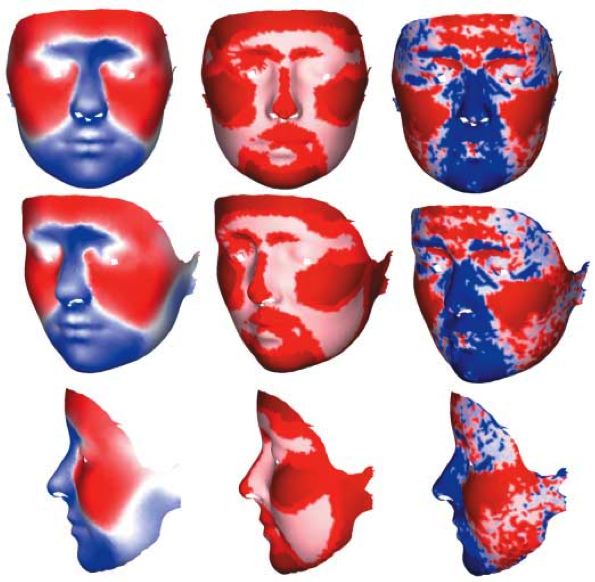On the feminine vs. masculine page, until now I had mostly relied on the skull to describe variation in face shape resulting from masculinization and feminization. I came across a new study that used 3D laser scanning and geometric morphometrics to describe the details of such variation in living people, and I added the finds to said page. I am posting the data here for the readers who typically check the blog for site updates, and will be including additional information that will be of special interest to feminists.
In the 3x3 image series below, the middle column represents the male-female average (northwest Europeans); the left and right columns represent equal displacements in the male and female direction, respectively. The differences between the left and right columns represent an approximately three-fold exaggeration of average male-female differences.

The 3x3 image series below describes how a female face is transformed by increased feminization. The left column shows the directionality of displacement of parts of the face; the blue part moves inward and the red part outwards; stronger color implies that the directionality of the displacement is closer to right angles to the surface. The middle column shows the magnitude of the displacement; stronger color implies greater magnitude of change; the color coding at each point is in 33% percentiles. The right column shows change in [local] surface area; red implies increase and blue decrease; color coding at each point is in 33% percentiles, with darker colors implying the upper percentiles. /p>

Increasing feminization causes the following important facial changes:
(key in a standing person: anterior = toward front, posterior = toward back, superior = above, inferior = below, medial = toward midline, coronal plane = vertical plane dividing body into anterior-posterior parts)
- The upper lip and philtrum area is displaced posteriorly and superiorly, and reduced in area, especially in the middle part.
- The nose becomes narrower along its length, reduces in area and is displaced posteriorly. The tip of the nose moves posteriorly, making the nose become relatively shorter, and the tip is also displaced superiorly, which turns up the tip of the nose.
- The cheeks expand in area and are displaced outwards.
- The chin reduces in area and is displaced superiorly and posteriorly. The angle of the mandible is displaced toward the middle of the face, and the mandible is reduced in relative length.
- The inferior ear attachment is displaced medially whereas the superior ear attachment is displaced inferiorly, leading to an overall rotation of this area in the coronal plane.
- “The superior medial orbital margins are displaced superiorly and posteriorly whereas the superior lateral margins are displaced laterally; the lateral margins are displaced laterally.”
- The medial forehead is displaced anteriorly and expands laterally; the lateral aspects are displaced anteriorly without lateral expansion.
Now, the cool results for feminists. The authors attempted to assess whether variation in face shape corresponded to variation in visuospatial ability and verbal fluency. Face shape variation was associated with visuospatial ability in men but not in women, and verbal fluency in women but not in men, which is roughly the same picture obtained when one attempts to correlate brain structures with these cognitive abilities. This similarity should not be surprising given that large parts of the face and the brain function as a developmental unit. Additionally, women, on average, outperform men with respect to verbal fluency and are outperformed by men on a number of visuospatial tasks. Interesting times are surely ahead for research addressing the why behind this discrepancy. The paper is available in pdf format, and feminists in particular should read it.
References:
- Hennessy RJ, McLearie S, Kinsella A, Waddington JL. Facial surface analysis by 3D laser scanning and geometric morphometrics in relation to sexual dimorphism in cerebral—craniofacial morphogenesis and cognitive function. J Anat. 2005;207(3):283-95.